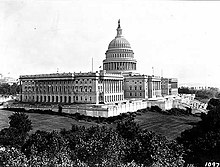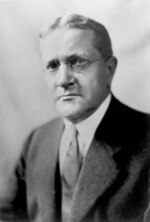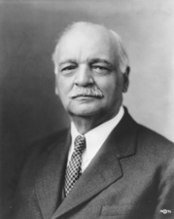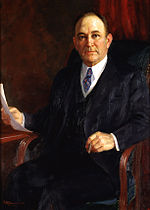70th United States Congress
| 70th United States Congress | |
|---|---|
69th ← → 71st | |
 United States Capitol (1906) | |
March 4, 1927 – March 4, 1929 | |
| Members | 96 senators 435 representatives 5 non-voting delegates |
| Senate majority | Republican |
| Senate President | Charles G. Dawes |
| House majority | Republican |
| House Speaker | Nicholas Longworth |
| Sessions | |
| 1st: December 5, 1927 – May 29, 1928 2nd: December 3, 1928 – March 3, 1929 | |
The Seventieth United States Congress was a meeting of the legislative branch of the United States federal government, consisting of the United States Senate and the United States House of Representatives. It met in Washington, D.C. from March 4, 1927 to March 4, 1929, during the last two years of Calvin Coolidge's presidency. The apportionment of seats in the House of Representatives was based on the Thirteenth Decennial Census of the United States in 1910. Both chambers had a Republican majority.
Major events
- November 6, 1928: U.S. Senate elections and U.S. House elections
Major legislation
- March 10, 1928: Settlement of War Claims Act
- May 15, 1928: Flood Control Act of 1928 (Jones–Reid Act)
- May 22, 1928: Merchant Marine Act of 1928 (Jones–White Act)
- May 22, 1928: Forest Research Act (McSweeney–McNary Act)
- May 22, 1928: Capper–Ketcham Act
- May 28, 1928: Welsh Act
- May 29, 1928: Revenue Act of 1928, ch. 852, 45 Stat. 791
- May 29, 1928: Reed–Jenkins Act
- December 21, 1928: Boulder Canyon Project Act (Hoover Dam)
- December 22, 1928: Color of Title Act
- January 19, 1929: Hawes–Cooper Act
- February 18, 1929: Migratory Bird Conservation Act (Norbeck–Anderson Act), ch. 257, 45 Stat. 1222
- March 2, 1929: Increased Penalties Act (Jones–Stalker Act)
Party summary

The count below identifies party affiliations at the beginning of the first session of this Congress, and includes members from vacancies and newly admitted states, when they were first seated. Changes resulting from subsequent replacements are shown below in the "Changes in membership" section.
Senate
| Party (shading shows control) |
Total | Vacant | |||
|---|---|---|---|---|---|
| Democratic (D) |
Farmer– Labor (FL) | Republican (R) |
|||
| End of previous congress | 42 | 1 | 53 | 96 | 0 |
| Begin | 47 | 1 | 48 | 96 | 0 |
| End | 45 | 50 | |||
| Final voting share | 46.9% | 1.0% | 52.1% | ||
| Beginning of next congress | 39 | 1 | 55 | 95 | 1 |
House of Representatives
| Party (shading shows control) |
Total | Vacant | |||||
|---|---|---|---|---|---|---|---|
| Democratic (D) |
Farmer– Labor (FL) | Republican (R) | Socialist (S) | Other |
|||
| End of previous congress | 183 | 3 | 247 | 1 | 1 | 435 | 0 |
| Begin | 204 | 5 | 224 | 1 | 0 | 434 | 1 |
| End | 203 | 219 | 428 | 7 | |||
| Final voting share | 47.4% | 1.2% | 51.2% | 0.2% | 0.0% | ||
| Beginning of next congress | 164 | 1 | 270 | 0 | 0 | 435 | 0 |
Leadership
Senate
Majority (Republican) leadership
Minority (Democratic) leadership
House of Representatives
Majority (Republican) leadership
Minority (Democratic) leadership
Members
This list is arranged by chamber, then by state.
Senate
Senators are listed in order of seniority at the beginning of this Congress.
Senators were elected every two years, with one-third beginning new six-year terms with each Congress. Preceding the names in the list below are Senate class numbers, which indicate the cycle of their election. In this Congress, Class 1 meant their term ended with this Congress, requiring re-election in 1928; Class 2 meant their term began in the last Congress, requiring re-election in 1930; and Class 3 meant their term began with this Congress, requiring re-election in 1932.
House of Representatives
Members of the House of Representatives are listed by district.
Changes in membership
The count below reflects changes from the beginning of the first session of this Congress.
Senate
| State | Senator | Reason for Vacancy | Successor | Date of Successor's Installation |
|---|---|---|---|---|
| Illinois (3) |
Frank B. Willis (R) | Smith was not permitted to qualify, and resigned February 9, 1928. Winner was elected to finish the term. |
Otis F. Glenn (R) | December 3, 1928 |
| New Mexico (1) |
Andrieus A. Jones (D) | Died December 20, 1927 Successor was appointed to continue the term. |
Bronson M. Cutting (R) | December 29, 1927 |
| Michigan (1) |
Woodbridge N. Ferris (D) | Died March 23, 1928 Successor was appointed to continue the term. Successor was then elected November 6, 1928 to finish the term. |
Arthur H. Vandenberg (R) | March 31, 1928 |
| Ohio (3) |
Frank B. Willis (R) | Died March 30, 1928. Successor was appointed to continue the term. |
Cyrus Locher (D) | April 4, 1928 |
| Idaho (3) |
Frank R. Gooding (R) | Died June 24, 1928. Successor was appointed to continue the term. Successor was then elected November 6, 1928 to finish the term. |
John W. Thomas (R) | June 30, 1928 |
| New Mexico (1) |
Bronson M. Cutting (R) | Appointee resigned December 6, 1928 when successor was elected to finish the term. | Octaviano A. Larrazolo (R) | December 7, 1928 |
| Delaware (2) |
T. Coleman du Pont (R) | Resigned December 9, 1928. Successor was elected to finish the term. |
Daniel O. Hastings (R) | December 10, 1928 |
| Ohio (3) |
Cyrus Locher (D) | Appointee resigned December 14, 1928 when successor was elected to finish the term. | Theodore E. Burton (R) | December 15, 1928 |
House of Representatives
- Replacements: 15
- Democratic: 1 seat net gain
- Republican: 1 seat net loss
- Deaths: 16
- Resignations: 6
- Total seats with changes: 22
Officers
Senate
- Chaplain: John J. Muir, (Baptist)
- ZeBarney T. Phillips (Episcopal), from December 5, 1927
- Secretary: Edwin P. Thayer
- Sergeant at Arms: David S. Barry
House of Representatives
- Chaplain: James S. Montgomery (Methodist)
- Clerk: William T. Page
- Doorkeeper: Bert W. Kennedy
- Sergeant at Arms: Joseph G. Rodgers
- Parliamentarian: Lewis Deschler
- Postmaster: Frank W. Collier
See also
References
- ^ Frank L. Smith (R-IL) was elected to the Senate for the term starting March 4, 1927, but the Senate refused to qualify him due to charges of corruption concerning his election. He resigned February 9, 1928. See http://bioguide.congress.gov/scripts/biodisplay.pl?index=S000534
- ^ William S. Vare (R-PA) was elected to the Senate for the term starting March 4, 1927, but the Senate refused to qualify him due to charges of corruption and fraud concerning his election. In the next Congress, the Senate unseated him. See http://bioguide.congress.gov/scripts/biodisplay.pl?index=V000071
- Martis, Kenneth C. (1989). The Historical Atlas of Political Parties in the United States Congress. New York: Macmillan Publishing Company.
- Martis, Kenneth C. (1982). The Historical Atlas of United States Congressional Districts. New York: Macmillan Publishing Company.










